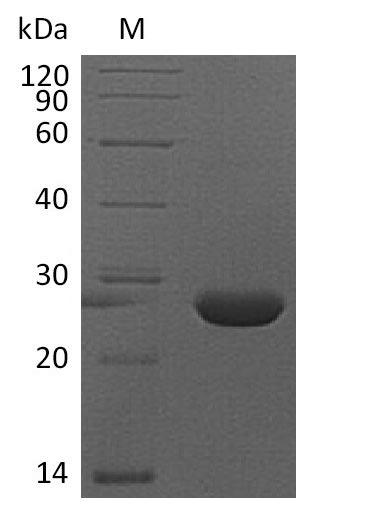Recombinant Mouse Fibroblast Growth Factor 9 (Fgf9) is produced in E.coli and covers the full length of the protein, spanning amino acids 1-208. The protein comes with an N-terminal 6xHis tag to make purification and detection more straightforward. Purity levels appear quite high, exceeding 95% based on SDS-PAGE analysis. Endotoxin content remains low at less than 1.0 EU/µg, as verified by the LAL method. The protein shows confirmed biological activity with an ED50 of 4.14 ng/ml in cell proliferation assays using Balb/3T3 mouse embryonic fibroblast cells.
Fibroblast Growth Factor 9 (Fgf9) belongs to the fibroblast growth factor family and plays important roles in cell growth, differentiation, and development. It seems particularly crucial for regulating embryonic development and tissue repair processes. When Fgf9 interacts with specific receptors, it activates signaling pathways that drive essential cellular processes. This makes it an attractive target for research in developmental biology and regenerative medicine.
Potential Applications
Note: The applications listed below are based on what we know about this protein's biological functions, published research, and experience from experts in the field. However, we haven't fully tested all of these applications ourselves yet. We'd recommend running some preliminary tests first to make sure they work for your specific research goals.
1. Cell Proliferation and Growth Factor Signaling Studies
This recombinant mouse Fgf9 protein is confirmed to be biologically active (ED₅₀ 4.14 ng/ml in Balb/3T3 cells) and suitable for proliferation and signaling studies. However, the E. coli expression produces a non-glycosylated protein, which may alter stability or signaling kinetics compared to native glycosylated Fgf9. The N-terminal His-tag might cause minor steric hindrance, potentially affecting receptor binding or dimerization. Researchers should validate that signaling pathways (e.g., MAPK, PI3K) and proliferation kinetics match those induced by mammalian-expressed Fgf9 in their specific cell models.
2. Receptor Binding and Interaction Studies
The biologically active Fgf9 can be used for receptor binding studies, but the N-terminal His-tag may sterically interfere with FGFR binding or heparin interactions if the N-terminus is involved in receptor engagement. While the tag facilitates immobilization for techniques like SPR, binding kinetics should be validated with tag-free Fgf9 to ensure accuracy. The non-glycosylated state may also affect binding affinity, so comparisons with mammalian-expressed Fgf9 are recommended for physiological relevance.
3. Antibody Development and Validation
This full-length Fgf9 serves as a good antigen for antibody development, but antibodies generated against this E. coli-expressed, non-glycosylated protein may not fully recognize native glycosylated Fgf9 in mouse tissues. The His-tag could induce tag-specific antibodies, so screening should include tag-free controls. Comprehensive validation should test antibody specificity against mammalian-derived Fgf9 to ensure recognition of physiological forms.
4. Comparative Species and Functional Studies
The protein enables valid comparative studies, but the E. coli expression and non-glycosylated state may unfairly simplify comparisons, as native Fgf9 is glycosylated and may have different functional properties. Researchers should account for expression system differences when comparing with mammalian-expressed Fgf9 from other species. The mouse-specific sequence is appropriate for cross-species analyses, but kinetic parameters may not directly translate to glycosylated forms.
5. Drug Screening and Inhibitor Development
The biologically active Fgf9 is suitable for screening assays, but the non-glycosylated form may respond differently to inhibitors compared to native Fgf9. The established ED₅₀ provides a baseline for high-throughput screening, but hit compounds should be validated with mammalian-expressed Fgf9 to ensure relevance to physiological conditions. The His-tag might also affect compound binding if inhibitors target the N-terminal region.
Final Recommendation & Action Plan
This recombinant mouse Fgf9 expressed in E. coli with an N-terminal His-tag is a functional tool with confirmed bioactivity, but researchers should account for its non-glycosylated state and potential tag-related artifacts. For immediate use, employ it in the 1-10 ng/ml range based on the ED₅₀, but validate dose-response in relevant cell types beyond Balb/3T3 cells. When studying receptor binding or signaling, consider tag cleavage or include tag-free controls for precise measurements. For antibody development, use this protein for immunization, but validate against native Fgf9 from mouse tissues. In comparative studies, acknowledge that the lack of glycosylation may affect functional comparisons with glycosylated proteins. For drug screening, the protein is adequate for initial assays, but prioritize validation of hits with mammalian-expressed Fgf9. Always include appropriate controls (e.g., vehicle, tag-only) to minimize artifacts, and consider that different cell types may exhibit varying sensitivity due to differences in FGFR expression and heparin sulfate dependence.






